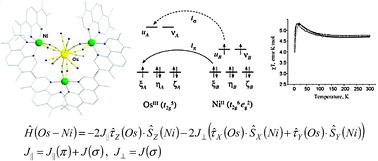Beyond the spin model: exchange coupling in molecular magnets with unquenched orbital angular momenta†
Abstract
In this critical review we review the problem of exchange interactions in polynuclear metal complexes involving orbitally degenerate metal ions. The key feature of these systems is that, in general, they carry an unquenched orbital angular momentum that manifests itself in all their magnetic properties. Thus, interest in degenerate systems involves fundamental problems related to basic models in magnetism. In particular, the conventional Heisenberg–Dirac–Van Vleck model becomes inapplicable even as an approximation. In the first part we attempt to answer two key questions, namely which theoretical tools are to be used in the case of degeneracy, and how these tools can be employed. We demonstrate that the exchange interaction between orbitally degenerate metal ions can be described by the so-called orbitally-dependent exchange Hamiltonian. This approach has shown to reveal an anomalously strong magnetic anisotropy that can be considered as the main physical manifestation of the unquenched orbital angular momentum in magnetic systems. Along with the exchange coupling, a set of other interactions (such as crystal field effects, spin–orbit and Zeeman coupling), which are specific for the degenerate systems, need to be considered. All these features will be discussed in detail using a pseudo-spin-1/2 Hamiltonian approach. In the second part, the described theoretical background will be used to account for the magnetic properties of several magnetic metal clusters and low-dimensional systems: (i) the dinuclear face-sharing unit [Ti2Cl9]3−, which exhibits a large magnetic anisotropy; (ii) the rare-earth compounds Cs3Yb2Cl9 and Cs3Yb2Br9, which, surprisingly, exhibit a full magnetic isotropy; (iii) a zig-zag CoII chain exhibiting unusual combination of single-chain magnet behavior and antiferromagnetic exchange coupling; (iv) a trigonal bipyramidal Ni3Os2 complex; (v) various CoII clusters encapsulated by polyoxometalate ligands. In the two last examples a pseudospin-1/2 Hamiltonian approach is applied to account for the presence of exchange anisotropy (150 references).

- This article is part of the themed collection: Molecule-based magnets

 Please wait while we load your content...
Please wait while we load your content...